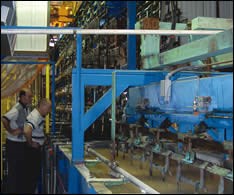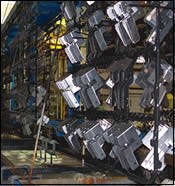Plating for Growth
A new rack plating line has enabled Elkhart Plating to expand into new markets without compromising its barrel zinc plating expertise...
For Bill McDowell, general manager at Elkhart Plating Corp. (Elkhart, IN) and a third-generation plater, the formula for running a successful plating business is simple. “Do one thing and do it well,” he says.
As it turns out, McDowell's advice is something of an unofficial company philosophy at Elkhart. Even as it has become somewhat trendy for job shops to grow their business by introducing new processes (sometimes to the point of lacking a true expertise in any one process or service), Elkhart has been squarely focused on what it does best (zinc plating), and sought out opportunities for expansion within its market segment, a form of "vertical expansion," if you will.
Featured Content
But it wasn't always that way. Established by the Bock family in 1919 as Ideal Plating, the company offered a variety of plating services. In 1955, Ideal Plating moved to its present location in Elkhart, which is in North Central Indiana.
In 1985, George Malcolm purchased Ideal Plating, and the company was renamed Elkhart Plating Corp. Malcolm had the building totally emptied, steam cleaned, painted and outfitted with an automatic barrel line for alkaline-non-cyanide zinc plating. He had intended on using the facility as a captive shop for the plating of imported fasteners, but the quality of the parts made it difficult, if not impossible, to plate with alkaline non-cyanide zinc. Consequently, the shop reopened its doors to outside customers.
Today, Elkhart continues to focus exclusively on alkaline non-cyanide zinc plating for a wide variety of customers. Most of the work performed there is done on an “on demand” basis for customers within an 80-mile radius. One- or two-day turnarounds on large quantities of parts are not uncommon. By the end of the year, the facility will have processed a little more than 20 million pounds of steel.
Located in the heart of the nation's recreational vehicle industry—virtually every major RV manufacturer is headquartered, or has a major presence, in the immediate area—it might be very tempting for Elkhart to target that industry exclusively. But that's not the case, says General Manager Bill McDowell. “We wanted to make sure all our eggs weren't in one basket.” So even as Elkhart's staff holds steadfastly to the idea of being the best it can at a single process, the company reaches out to a wide variety of industries, including construction, agriculture, appliance, automotive and screw machine and stampings.
This desire to reach a broad number of industries was realized in the company's purchase of a new rack plating line, a decision made as much on the basis of developing new business as holding on to existing customers. “We knew that for Elkhart Plating to keep its doors open, we had to offer both barrel and rack plating,” says McDowell. “A lot of our customers were using us for barrel plating but had to go to another shop for rack plating. Sooner or later, there would be somebody in the area who could offer both rack and barrel plating, and we wanted to make sure that somebody was Elkhart Plating.”
The decision to expand its service offerings presented McDowell with a comfortable growth opportunity. “We've been able to broaden our reach, without deviating from our area of expertise [zinc plating],” he says.
Vertical Expansion
In 1999, McDowell went through the exercise of getting quotes for a building expansion for a rack zinc line. Though the expansion was not approved at the time, it was revisited—and ultimately approved—in November 2002. In August 2003, Elkhart Plating broke ground for a 15,000-sq-ft addition, doubling the size of the facility and providing the necessary floorspace for the new plating system.
McDowell and his management team—including Don Penzenik, Elkhart's environmental manager—designed the new plating system themselves, drawing on their years of industry experience and familiarity with the logistics of the shop. While they considered programmable hoist type systems—generally well regarded for their ease of maintenance and efficient productivity—the team ultimately opted for a return-type rack machine, which they saw as being a slightly better fit for the company's specific needs. Once the design was completed, McDowell turned to Cleveland-based Fanta Equipment Co. for construction and installation of the line.
The new rack line features 33 plating cells, including a double cleaning cycle (soak clean, 50% hydrochloric acid, reverse current electroclean, followed with a 25% hydrochloric acid) and has the capability of applying clear, yellow, black or olive drab chromates and a seal on line. The plating tanks hold approximately 9,000 gallons of solution and are deep enough to plate lengths up to 5 ft in length vertically. Using controls, all chemicals are added to the line automatically, which helps maximize overall efficiency of the system.
While designing the new system, McDowell and Penzenik called for an enclosure to be built around the part of the line containing the alkaline baths. “Our motivation was two fold,” says Penzenik. “The idea is to keep any particulate matter from escaping the line and coming back out on fresh parts. We also knew that it would provide a more comfortable environment for the employees doing the racking and unracking on the other side of the line.” The enclosed room is equipped with an air make-up system for pumping fresh air in.
The installation of the new plating line has also provided the shop with an additional opportunity for energy conservation. Rather than pay for city water, Elkhart now draws 55°F well water from the ground and runs it through its plate and frame heat exchanger. This non-contract cooling water is then put back into the ground via a Geothermal well.
For maintaining workflow within the facility, McDowell and Penzenik spent three years developing their own computer software program that performs a variety of functions, such as maintaining parts lists, accounting and tracking of deliveries. “We were having a lot of trouble finding software that could do everything we wanted it to do,” says McDowell of the decision to develop their own software. “In the end, we just decided to do it ourselves.” The software has been so successful meeting Elkhart's needs that the company is considering patenting and marketing it to other platers in 2005.
Although McDowell says that the process of designing a system was not without its headaches, both he and Penzenik say they would do it again in a heartbeat. “We did, at times, experience the pains of growing, but ultimately, this made us a stronger company,” says McDowell. The two attribute the success of the project to the shop's team of managers. “The hiring and retention of good managers has always been key to our continued growth,” Penzenik adds.
As for the new line, it began production in late April 2004. Though McDowell had initially anticipated that it would be mid-August before the company had enough work to warrant running it 24 hours a day, enough work poured in that he was forced to begin 24-hour production two full months ahead of schedule. “It's a good problem to have,” he says.
ABOUT ELKHART PLATING
Founded 1919, Elkhart Plating specializes in alkaline non-cyanide zinc rack and barrel plating.
Elkhart Plating Corp.
1913 South 14th Street
P.O. Box 74
Elkhart, IN 46515
Phone: (574) 294-1800
Fax: (574) 295-1603
E-mail: mcdowell@elkhartplating.com
RELATED CONTENT
-
Masking for Surface Finishing
Masking is employed in most any metal finishing operation where only a specifically defined area of the surface of a part must be exposed to a process. Conversely, masking may be employed on a surface where treatment is either not required or must be avoided. This article covers the many aspects of masking for metal finishing, including applications, methods and the various types of masking employed.
-
Smut and Desmutting
Question: I am new to this industry and have heard about smut and desmutting operations.
-
Gold and Silver Plating Basics
An overview of precious metal electroplating processes.






















